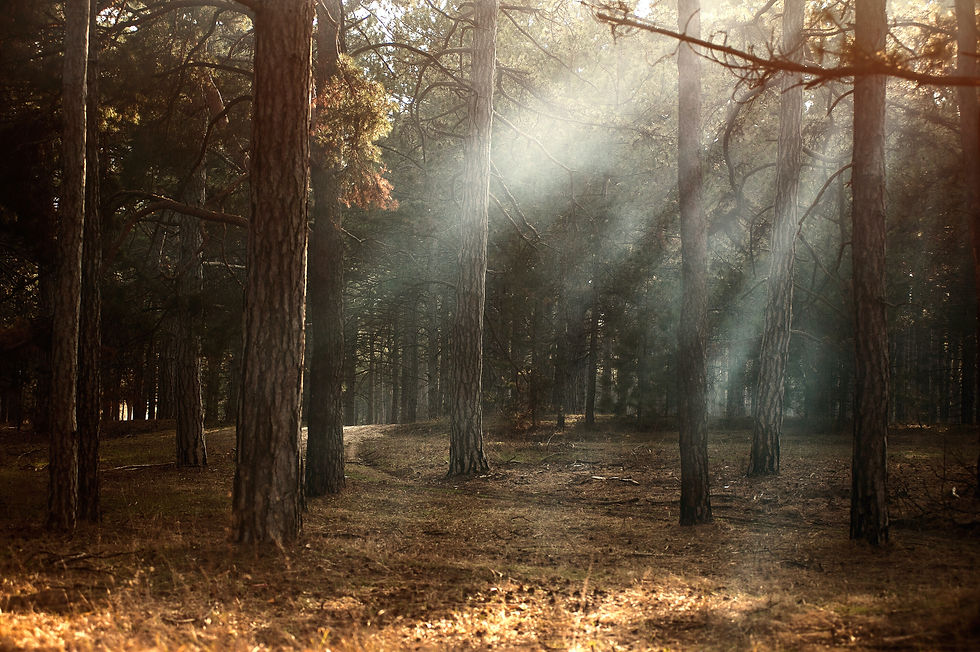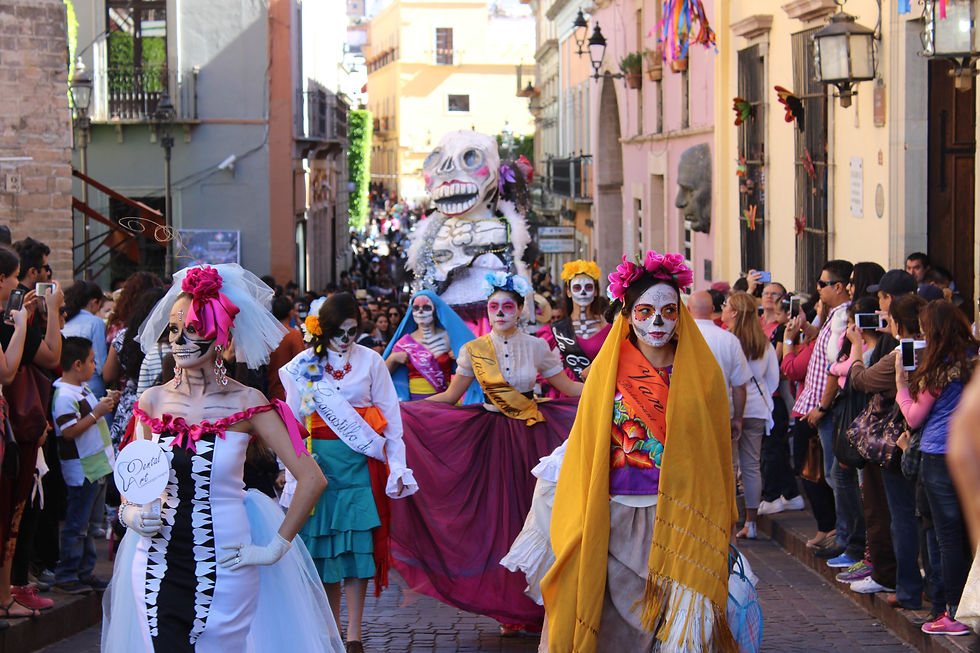Celebrating the dead for Día de Los Muertos
- Shelagh Hogan
- Oct 24, 2022
- 5 min read
Updated: Oct 7, 2023
It's October. The height of autumn, one of my favorite seasons. The days get cooler, and the leaves begin to change and fall from the trees. Here in the U.S. there are folks carving pumpkins, getting lost in hay mazes, drinking hot cider and picking out the costumes in which they will take their kids to “trick-or-treat” on Halloween night, October 31st. Halloween, or All Hallows Eve is a day that has morphed over the years from its Celtic origins into the rather commercial spectacle that it is today in North America.

In general, it was a celebration marking the end of the summer harvest and the approach of winter. The theme being the end of the life cycle, and the beginning of death symbolized by the approaching winter. During those festivals it was believed that the ghosts of the dead could return to the land of the living. On the other side of the world, in Central America, Mesoamerican tribes of what is now Mexico were celebrating the cycle of life in its embrace of death. These indigenous traditions became enmeshed with those of European colonists to bring what is now celebrated as Día de Los Muertos.
What is Día de Los Muertos?
Día de los Muertos, or Day of the Dead, is a two-day celebration on November 1st and 2nd, honoring those who have passed before us. Beginning at midnight on October 31st, it is believed that the spirits of the deceased may return to the realm of the living. More specifically, November 1st is also called Día de los Inocentes, day of the innocents, when the spirits of departed children are able to return to their living relatives. Then, on November 2nd, the spirits of the adult deceased return. Throughout these two days, los Muertos are welcomed back and commemorated with prayer, music, food, and dancing.
Day of the Dead Origins in Central America

The Day of the Dead origins can be traced back to the Mesoamerican societies among the Aztec empire, who celebrated death for an entire month during what is now the month of August. The festivities were centered around the Aztec goddess of death, Mictecacíhuatl, who was believed to guard the bones of the dead and ruled the underworld.
When the Spanish conquistadors colonized Mexico, they brought Catholicism with them. In an attempt to stamp out the native religious practices with Catholic ones, the indigenous “death” celebrations were moved from August to November coincide with All Saints Day and All Souls Day on November 1st and 2nd. Many of the indigenous symbols and practices were maintained and combined with some Christian traditions to make what is a unique celebration of death.
What are some Día de Los Muertos traditions?
Día de Los Muertos is celebrated all throughout Mexico (as well as other countries in the Americas). Traditions may vary from locality to locality, but these traditions are common:

Altares (altars) are built to honor deceased loved ones. Perhaps the most important tradition, the altars are adorned with pictures of the deceased, flowers, and candles. These shrines can be built in cemetaries, along public buildings and streets, and are often in the privacy of the home. Some of these altars take months to build, and the shrines are truly gorgeous.
Ofrendas, or offerings, are set upon the altar to greet the deceased upon his/her return. These can be items like toys and candy if the deceased was a child.
Delicious meals, usually the deceased’s favorite, are prepared and offered on the altar.
Some Common Day of the Dead recipes are:
Pan de muertos, or bread of the dead.
Mole Negro, Black Mole
Calaveras de azúcar, sugar skulls (right)
Altars are also decorated with cempasúchil, or the marigold flower, which is believed to guide the dead back from the other side with its bright colors and fragrance. The flower is also used in several recipes for Día de Los Muertos, such as tortillas de cempasúchil.
What is Calavera Catrina?
“La Calavera Catrina,” also known as “La Catrina'' is now an icon of the Day of the Dead. Originally, a drawing depicting a smiling skeleton in an elegant floral bonnet was created by artist Jose Guadalupe Posada. He called her “La Garbancera.” Posada was a political cartoonist during the time of the Mexican Revolution, often critiquing indigenous Mexicans for aspiring to be like the Europeans that colonized Central America. His theme was often portraying people as skeletons in his drawings, because, regardless of social class or ethnicity, we are all the same underneath and in the end, death is the common destination that we all share.
La Catrina re-emerged in Diego Rivera’s famous mural “Sueño de una tarde dominical en la Alameda Central” where she is portrayed in the center of the mural escorted by her artist, Jose Guadalupe Posada, and they are surrounded by other well-known Mexicans.
La Calavera Catrina is now commonly seen during Día de los Muertos celebrations as the patroness. Perhaps this is a nod to the Indigenous death celebrations honoring Mictecacíhuatl, the goddess of death.
Participants often paint their faces and dress as Catrina and are seen dancing in parades in various cities.

Tips for attending Dia de Los Muertos Festivals in Latin America
Be Respectful. Día de los Muertos is about families honoring their deceased loved ones and death’s role in the cycle of life. If you are visiting from another country, it is best to leave the traditions associated with coinciding holidays (*ahem* Halloween) behind and observe and participate in Day of the Dead festivities.
Plan early! Día de los Muertos is now a huge celebration throughout Mexico and Latin America. It attracts many visitors from around the world. If you plan your visit to include Día de los Muertos it is wise to book your accommodations and any tours/guides well in advance as they often get booked out.
Ear plugs. Modern Day of the Dead festivities are loud and can run late into the night. You may benefit from packing ear plugs to get some rest after you’ve retired, so you can start the next day of your trip fresh.
Pay attention. Crowd awareness and common sense are always important in any festival or parade setting. Watch where you’re walking so as not to disturb any ofrendas or altares.
Participate and celebrate. Join in if you’re comfortable and invited. Día de los Muertos is a positive celebration of death, and many people are happy to share memories of those they are honoring. Maybe you have a loved one whose life you’d like to celebrate as well.
Día de los Muertos is a colorful, happy celebration honoring death’s role in the cycle of life. The inevitable next step that we all must take when our time on earth is finished. A positive association with death helps us appreciate and celebrate life.
Note: We make our best efforts to ensure information is as accurate as possible. If you notice any discrepancies, please contact.
If you’re looking for ways to travel with more intention, subscribe to our mailing list, and follow Conscious Travel Collective on IG or FB. We craft private small group travel for those looking for meaningful connection to places and people, so when you are ready to experience for yourself, we are here help make it happen!
The author of this blog is the oh-so-talented, Shelagh Hogan.
You can find out more about her work on our team page
References:
Editors, History.com. “Day of the Dead” www.history.com. A&E Television Networks, 22 Nov. 2022. Sat. 22 Oct. 2022.< https://www.history.com/topics/halloween/day-of-the-dead >.
Ward, Logan. “10 things to know about the Day of the Dead” www.nationalgeographic.co.uk. National Geographic, 22 Nov. 2022. Sat. 22 Oct. 2022.< https://www.nationalgeographic.co.uk/travel-and-adventure/top-10-things-know-about-day-dead >.
Editors, History.com. “Halloween 2022” www.history.com. A&E Television Networks, 19 Nov. 2022. Sat. 22 Oct. 2022.< https://www.history.com/topics/halloween/history-of-halloween >.
Rousey, Sandra. “Day of The Dead: Who is La Catrina?” dayofthedead.holiday. Dayofthedead.holiday, 22 Nov. 2022. Sat. 22 Oct. 2022.< https://dayofthedead.holiday/traditions/who-is-la-catrina/ >.
Ingram, Simon. “Day of The Dead: Who is La Catrina?” dayofthedead.holiday. A&E Television Networks, 18 Nov. 2019. Sat. 22 Oct. 2022.< https://dayofthedead.holiday/traditions/who-is-la-catrina/ >.



Comments